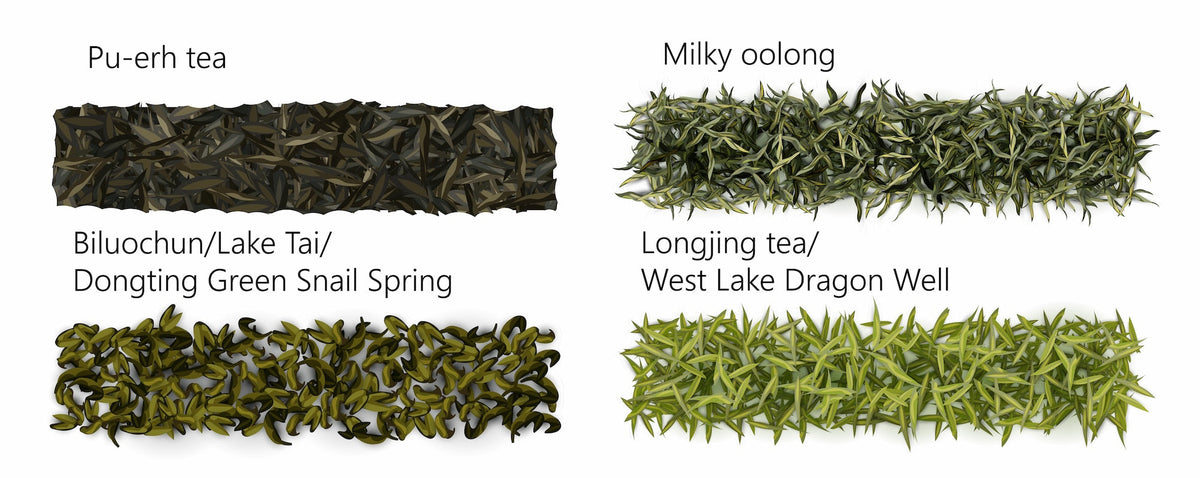
A Complete Guide to Tea Flavors: Exploring Different Types of Tea and Unique Varieties
|
|
Time to read 4 min
|
|
Time to read 4 min
Tea is one of the world’s most beloved beverages, enjoyed by millions for its diverse flavors, rich history, and numerous health benefits. Whether you prefer a delicate white tea, a robust black tea, or a floral green tea, there is a flavor for every palate. But with so many options, how many kinds of teas are there, and what makes each variety unique?
This article will explore the different types of tea, provide a tea varieties list, and answer questions like how many teas are there and what unique tea flavors you can try. Whether you're a seasoned tea enthusiast or a beginner, this guide will help you understand the kinds of tea available and how to choose the best one for you.
All true teas come from the Camellia sinensis plant. The difference between them lies in how they are processed, their level of oxidation, and their region of cultivation. Below, we explore the different types of tea and their flavor profiles.
White tea is the least processed among all types of tea, made from young tea buds and leaves that are simply withered and dried. It offers a delicate, natural sweetness.
Common White Tea Flavors:
Floral (e.g., jasmine, peony)
Light honey or apricot-like sweetness
Fresh and slightly vegetal
Popular White Tea Varieties:
Silver Needle (Bai Hao Yin Zhen) – One of the highest-quality white teas, known for its sweet and floral taste.
White Peony (Bai Mu Dan) – A fuller-bodied white tea with fruity and earthy notes.
Green tea is lightly oxidized, preserving its fresh, vegetal, and grassy flavors. Japanese green teas tend to have more umami notes, while Chinese green teas can be nutty or floral.
Common Green Tea Flavors:
Grassy, vegetal, and slightly umami
Floral and sweet in lighter varieties
Nutty and roasted in some Chinese green teas
Popular Green Tea Varieties:
Matcha – A powdered Japanese green tea with a rich, creamy texture and umami flavor.
Sencha – A Japanese green tea with a refreshing, slightly sweet taste.
Dragon Well (Longjing) – A Chinese green tea with chestnut-like sweetness.
Oolong tea is partially oxidized, meaning it falls between green and black tea. The oxidation level can range from lightly floral to deeply roasted.
Common Oolong Tea Flavors:
Floral and creamy (lighter oolongs)
Roasted, nutty, and caramel-like (darker oolongs)
Complex, evolving flavors with multiple infusions
Popular Oolong Tea Varieties:
Tie Guan Yin (Iron Goddess of Mercy) – A floral and creamy oolong from China.
Da Hong Pao (Big Red Robe) – A famous Wuyi rock tea with deep roasted flavors.
Milk Oolong – Naturally creamy and buttery.
Black tea is fully oxidized, giving it a dark color and a robust flavor. It is one of the most widely consumed kinds of tea, especially in the West.
Common Black Tea Flavors:
Malty and rich (Assam)
Fruity and brisk (Darjeeling)
Smoky and bold (Lapsang Souchong)
Popular Black Tea Varieties:
Earl Grey – A black tea flavored with bergamot orange oil, giving it a citrusy aroma.
English Breakfast – A strong, malty blend perfect for milk and sugar.
Keemun – A Chinese black tea with wine-like and chocolatey notes.
Pu-erh is a fermented and aged tea from Yunnan, China. Unlike other teas, pu-erh improves with age , much like fine wine.
Common Pu-erh Tea Flavors:
Earthy and rich
Woody and smooth
Slightly sweet and nutty
Popular Pu-erh Tea Varieties:
Raw Pu-erh (Sheng Pu-erh) – A young, more astringent pu-erh that ages over time.
Ripe Pu-erh (Shou Pu-erh) – A smoother, deeper tea with a rich, earthy profile.
While there are five main types of tea, many subcategories exist, making the answer to how many teas are there complex. Below is a tea varieties list, including herbal teas and flavored teas.
Herbal teas are not true teas because they do not come from Camellia sinensis. Instead, they are made from dried herbs, flowers, and fruits.
Popular Herbal Tea Flavors:
Chamomile – Floral, honey-like, and calming.
Peppermint – Cool, refreshing, and invigorating.
Rooibos – Naturally sweet, nutty, and caffeine-free.
Some of the most unique tea flavors come from blending true teas with natural ingredients, such as flowers, spices, and fruits.
Examples of Unique Tea Flavors:
Jasmine Tea – Green or white tea scented with fresh jasmine blossoms.
Chai Tea – Black tea blended with spices like cinnamon, ginger, and cardamom.
Genmaicha – A Japanese green tea mixed with roasted rice, giving it a toasty flavor.
Elderflower Tea – Light, floral, and slightly citrusy.
Lavender Tea – A soothing, fragrant floral tea.
If you are overwhelmed by the variety of teas, use this guide to choose the perfect tea flavors based on your preferences.
For light and delicate flavors: Try white tea or lightly oxidized oolong tea.
For fresh and grassy notes: Choose Japanese green tea like Sencha or Matcha.
For bold and strong flavors: Opt for black tea like Assam or Keemun.
For earthy and aged flavors: Try pu-erh tea.
For sweet and floral notes: Enjoy jasmine tea, chamomile, or milk oolong.
For spiced and warming flavors: Go with chai tea or rooibos tea.
Tea is an incredibly diverse beverage with countless flavors, types, and varieties. Whether you are looking for unique tea flavors, exploring how many kinds of teas are there, or just starting with the basics, there is always something new to discover.
By understanding the different types of tea, you can find the perfect match for your taste—whether it’s the floral elegance of white tea, the refreshing briskness of green tea, or the deep, roasted complexity of oolong and black teas.
Next time you sip a cup of tea, take a moment to appreciate its history, complexity, and rich flavor profile —because every tea tells a story!
Describe your products, collection etc...
What are you looking for?






